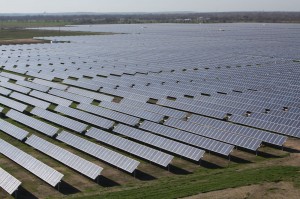But unlike West Texas wind farms, which produce power mostly in spring and fall and at night, solar plants are producing at their best in the heat of a Texas summer day. (Coastal wind farms, which are now coming into use, produce most of their power in the afternoons, including in the summer, and so are more helpful than West Texas wind generators for peak periods.)

“When do [utilities] need more generating capacity? At their peak [usage times],” Sinkin said. “When does solar produce the most? At the peak times.”
Even on not-so-sunny days, solar still produces. David Power, deputy director of Public Citizen’s Texas office, said that back in February, when cold weather and power plant outages produced blackouts, CPS’ solar farm was on line and producing. “It was a pretty nasty day, cloudy, and there was a couple of inches of ice on the solar farm,” he said. “But they were still getting 30 to 35 percent of normal production out of it, even on the worst day you could imagine.”
Costs for solar panels have dropped dramatically in the last few years, although by some measures solar energy is still more expensive than that from gas-burning plants.
Power said that the comparisons that show solar to be more expensive are measuring the cost of building a solar plant compared to generating power from a fossil-fuel plant that may have been built and paid for decades ago. In marginal cost comparisons, he said, solar power comes out as costing either the same or less than building a new natural gas plant. “For that you have to get air quality permits and pay for fuel costs,” he said. “For the other, the sun shines, you get electricity, and you just have to wash it off once in a while if it doesn’t rain.”
********
For Texans who get their power from companies that are part of the huge Energy Future Holdings group, figuring out who would be responsible for decisions like whether to build a solar plant, how to pay for it, and what incentives to offer residential solar panel users can be tough. One company owns the power lines, another is the retailer of power, and a third owns and operates the coal-, gas,- and nuclear-powered plants that produce the electricity. As with any for-profit company, what might be good for customers isn’t necessarily great for company managers and stockholders.
For electricity users in San Antonio and Austin, the equation is much simpler: Those cities own their electric utilities, and in the end it is the city councils, answerable to the taxpayers, that make the major decisions.
“Municipal utilities can make decisions on the basis of things other than the bottom line,” Sinkin said. They can factor in things like environmental effects, long-term stability of electric rates, and even economic development. When those cities have “enlightened leadership,” he said, the result is energy programs that, like those in Austin and San Antonio, are “way ahead of the curve.”
The programs that those two cities have put together go far beyond offering rebates for solar panels and encouraging conservation. They have attracted dozens of companies and hundreds of jobs to each city to participate in the “green economy” and have made solar power not just a money-saver but also a potential moneymaker for businesses and homeowners.
San Antonio, Sinkin said, already has about 30 megawatts of solar power on line, and is adding more. CPS had such great response to a request for bids on a 50-megawatt solar plant, he said, that eventually the utility withdrew the request and put out a new one asking for bids to build 400 megawatts of solar power. And, he said, the utility also required that the successful bidder bring jobs with them. The result, he said, will be a manufacturing plant with a guarantee of about 800 long-term jobs.
Doyle Beneby, the CEO of CPS, is “a force of nature” who “has added mission to CPS” from just generating power, Sinkin said, to growing the green economy.
CPS also has a program for commercial customers that install solar panels on their buildings. The utility agrees to buy all the power that the rooftop installation produces, at a premium price. “That creates an incentive for investors because it guarantees a return,” Sinkin said.
The utility is also seeking ways to reduce power demand in their system. The program, utilizing about 15 different rebates for consumers who do things like installing solar panels or buying energy-efficient appliances, has been so successful that the utility had to add to the money set aside to pay for the rebates, he said.
The rebates in turn have encouraged so many people to add solar panels, Sinkin said, that there are now about 25 companies in San Antonio that have installed more than $30 million worth of solar facilities. CPS “helped create a new industry that is fairly robust and growing,” he said.
One of Solar San Antonio’s contributions was to convene a forum of lenders to figure out ways to work with homeowners to finance solar installations. Because solar projects can be eligible for both tax credits and utility rebates, he said, a homeowner on a typical project might find his or her eventual loan amount to be only about a third of the initial amount, on a project that lowers home energy bills and pays for itself in less than 10 years. “It changed the financing picture,” he said.











Thanks to Gayle Reaves & FWW for a fine article & must-read for electricity consumers in Tx. After reading, I checked http://www.powertochoose.org & http://www.dsireusa.org/incentives for local providers & incentives for using renewables, especially solar. Nothing much in my area but impressive what Austin, San Antonio & other cities are doing. The industry is powerful, but with the looming system limitations & growing demand, local solar is a great option. I’ll be contacting my city & state reps to get more of these incentive programs rolling.
Geat article!
Someone. Start. Paying. Attention.
How can I help?
Solar City offers residents of DFW the same opportunities as those in Austin and San Antonio. The time is now to start turning Sunshine into Savings.